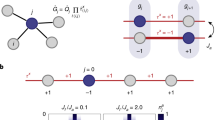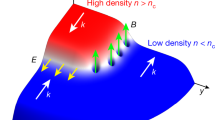Abstract
A potentially practical scheme is proposed to realize optical quantum simulation of artificial Abelian gauge field in a scalable architecture consisting of cold atomic ensembles with optical cavities. In the present model, the collective excitations of cold atomic ensembles can be converted to the bosonic modes within the low-excitation limit, where the structure of two-dimension (2D) square plaquette enables the polaritons to move like a charged particle subjected to an external magnetic field. We find that the energy spectrum of this hybrid system exhibits a shape of Hofstadter buttery. Our work provides a different perspective to the quantum simulation of condensed matter and many-body physics in the context of cavity quantum electrodynamics. The experimental feasibility are justified using the existing techniques.
Similar content being viewed by others
References
Feynman R. Simulating physics with computers. Int J Theor Phys, 1982, 21: 467–488
Celi A, Massignan P, Ruseckas J, et al. Synthetic gauge fields in synthetic dimensions. Phys Rev Lett, 2014, 112: 043001
Roscilde T. Thermometry of cold atoms in optical lattices via artificial gauge fields. Phys Rev Lett, 2014, 112: 110403
Stannigel K, Hauke P, Marcos D, et al. Constrained dynamics via the Zeno effect in quantum simulation: Implementing non-Abelian lattice gauge theories with cold atoms. Phys Rev Lett, 2014, 112: 120406
Struck J, Weinberg M, Ölschläger C, et al. Engineering Ising-XY spinmodels in a triangular lattice using tunable artificial gauge fields. Nat Phys, 2013, 9: 738–743
Peropadre B, Zueco D, Wulschner F, et al. Tunable coupling engineering between superconducting resonators: From sidebands to effective gauge fields. Phys Rev B, 2013, 87: 134504
Marcos D, Rabl P, Rico E, et al. Superconducting circuits for quantum simulation of dynamical gauge fields. Phys Rev Lett, 2013, 111: 110504
Fang K, Fan S. Controlling the flow of light using the inhomogeneous effective gauge field that emerges from dynamic modulation. Phys Rev Lett, 2013, 111: 203901
Burrello M, Fulga I C, Alba E, et al. Topological phase transitions driven by non-Abelian gauge potentials in optical square lattices. Phys Rev A, 2013, 88: 053619
Yang W L, Yin Z Q, Chen Z X, et al. Quantum simulation of an artificial Abelian gauge field using nitrogen-vacancy-center ensembles coupled to superconducting resonators. Phys Rev A, 2012, 86: 012307
Umucalılar R O, Zhai H, Oktel M Ö. Trapped Fermi gases in rotating optical lattices: Realization and detection of the topological Hofstadter insulator. Phys Rev Lett, 2008, 100: 070402
Juzeliūnas G, Ruseckas J, Jacob A, et al. Double and negative reflection of cold atoms in non-Abelian gauge potentials. Phys Rev Lett, 2008, 100: 200405
Shao L B, Zhu S L, Sheng L, et al. Realizing and detecting the quantum Hall effect without Landau levels by using ultracold atoms. Phys Rev Lett, 2008, 101: 246810
Osterloh K, Baig M, Santos L, et al. Cold atoms in non-Abelian gauge potentials: From the Hofstadter “Moth” to lattice gauge theory. Phys Rev Lett, 2005, 95: 010403
Ruseckas J, Juzeliūnas G, Öhberg P, et al. Non-Abelian gauge potentials for ultracold atoms with degenerate dark states. Phys Rev Lett, 2005, 95: 010404
Pietilä V, Möttöen M. Non-Abelian magnetic monopole in a Bose-Einstein condensate. Phys Rev Lett, 2009, 102: 0804
Pietilä V, Möttöen M. Creation of Dirac monopoles in spinor Bose-Einstein Condensates. Phys Rev Lett, 2009, 103: 0304
Zhang P, Li Y, Sun C P. Induced magnetic monopole from trapped Λ-type atom. Eur Phys J D, 2005, 36: 229–233
Qi X L, Li R D, Zang J D, et al. Inducing a magnetic monopole with topological surface states. Science, 2009, 323: 1184–1187
Sørensen A S, Demler E, Lukin M D. Fractional quantum Hall states of atoms in optical lattices. Phys Rev Lett, 2005, 94: 086803
Palmer R N, Jaksch D. High-field fractional quantum Hall effect in optical lattices. Phys Rev Lett, 2006, 96: 180407
Goldman N, Kubasiak A, Bermudez A, et al. Non-Abelian optical lattices: anomalous quantum Hall effect and Dirac Fermions. Phys Rev Lett, 2009, 103: 035301
Hofstadter D R. Energy levels and wave functions of Bloch electrons in rational and irrational magnetic fields. Phys Rev B, 1976, 14: 2239–2249
Dean C R, Wang L, Maher P, et al. Hofstadter’s butterfly and the fractal quantum Hall effect in Moiré superlattices. Nature, 2013, 497: 598–602
Ponomarenko L A, Gorbachev R V, Yu G L. Cloning of Dirac fermions in graphene superlattices. Nature, 2013, 497: 594–597
Weiss D. The butterfly emerges. Nat Phys, 2013, 9: 395–396
Moon P, Koshino M. Optical properties of the Hofstadter butterfly in the Moiré superlattice. Phys Rev B, 2013, 88: 241412
Satija I I, Naumis G G. Chern and Majorana modes of quasiperiodic systems. Phys Rev B, 2013, 88: 054204
Bhat R, Krämer M, Cooper J, et al. Hall effects in Bose-Einstein condensates in a rotating optical lattice. Phy Rev A, 2007, 76: 043601
Pedersen J G, Pedersen T G. Hofstadter butterflies and magnetically induced band-gap quenching in graphene antidot lattices. Phy Rev B, 2013, 87: 235404
Mueller E J. Artificial electromagnetism for neutral atoms: Escher staircase and Laughlin liquids. Phys Rev A, 2004, 70: 041603
Larson J, Levin S. Effective Abelian and Non-Abelian gauge potentials in cavity QED. Phys Rev Lett, 2009, 103: 013602
Goldman N, Kubasiak A, Gaspard P, et al. Ultracold atomic gases in non-Abelian gauge potentials: The case of constant Wilson loop. Phys Rev A, 2009, 79: 023624
Jaksch D, Zoller P. Creation of effective magnetic fields in optical lattices: The Hofstadter butterfly for cold neutral atoms. New J Phys, 2003, 5: 56
Juzeliúnas G, Öhberg P. Slow light in degenerate Fermi gases. Phys Rev Lett, 2004, 93: 033602
Wilczek F, Zee A. Appearance of gauge structure in simple dynamical systems. Phys Rev Lett, 1984, 52: 2111–2114
Jacob A, Öhberg P, Juzeliūnas G, et al. Landau levels of cold atoms in non-Abelian gauge fields. New J Phys, 2008, 10: 045022
Cooper N R, Wilkin N K, Gunn J M F. Quantum phases of vortices in rotating Bose-Einstein condensates. Phys Rev Lett, 2001, 87: 120405
Polini R, Fazio R, MacDonald A H, et al. Realization of fully frustrated josephson-junction arrays with cold atoms. Phys Rev Lett, 2005, 95: 010401
Schweikhard V, Tung S, Cornell E A. Vortex proliferation in the Berezinskii-Kosterlitz-Thouless regime on a two-dimensional lattice of Bose-Einstein condensate. Phys Rev Lett, 2007, 99: 030401
Rosenkranz M, Klein A, Jaksch D. Simulating and detecting artificial magnetic fields in trapped atoms. Phys Rev A, 2010, 81: 013607
Lin Y J, Compton R L, Jiménez-García K, et al. Synthetic magnetic fields for ultracold neutral atoms. Nature, 2009, 462: 628–632
Lin Y J, Compton R L, Perry A R, et al. Bose-Einstein condensate in a uniform light-induced vector potential. Phys Rev Lett, 2009, 102: 130401
Lin Y J, Compton R L, Jiménez-García K, et al. A synthetic electric force acting on neutral atoms. Nat Phys, 2011, 7: 531–534
Aidelsburger M, Atala M, Lohse M, et al. Realization of the Hofstadter Hamiltonian with ultracold atoms in optical lattices, Phys Rev Lett, 2013, 111: 185301
Zheng S B. Universal quantum logic gates in decoherence-free subspace with atoms trapped in distant cavities. Sci China-Phys Mech Astron, 2012, 55: 1571–1576
Xiang Z L, Yu T, Zhang W X, et al. Implementing a topological quantum model using a cavity lattice. Sci China-Phys Mech Astron, 2012, 55: 1549–1556
Yu X Y, Li J H, Li X B. Atom-atom entanglement characteristics in fiber-connected cavities system within the double-excitation space. Sci China-Phys Mech Astron, 2012, 55: 1813–1819
Liu Y M. Scheme for the preparation of macroscopic W-type state of atomic ensembles in cavity QED coulped with optical fibers. Sci China-Phys Mech Astron, 2013, 56: 2122–2127
Cho J, Angelakis D G, Bose S. Fractional quantum Hall state in coupled cavities. Phys Rev Lett, 2008, 101: 246809
Cho J, Angelakis D G, Bose S. Simulation of high-spin Heisenberg models in coupled cavities. Phys Rev A, 2008, 78: 062338
Yin Z Q, Li F F. Multiatom and resonant interaction scheme for quantum state transfer and logical gates between two remote cavities via an optical fiber. Phys Rev A, 2007, 75: 015324
Haas F, Volz J, Gehr R, et al. Entangled states of More than 40 atoms in an optical fiber cavity. Science, 2014, 344: 180–183
James D F V, Jerke J. Effective Hamiltonian theory and its applications in quantum information. Can J Phys, 2007, 85: 625–632
James D F V. Quantum computation with hot and cold ions: An assessment of proposed schemes. Fortschr Phys, 2000, 48: 823–837
Pellizzari T. Quantum networking with optical fibres. Phys Rev Lett, 1997, 79: 5242–5245
Yang W L, Yin Z Q, Xu Z Y, et al. One-step implementation of multiqubit conditional phase gating with nitrogen-vacancy centers coupled to a high-Q silica microsphere cavity. Appl Phys Lett, 2010, 96: 241113
Yang W L, Xu Z Y, Feng M, et al. Entanglement of separate nitrogen-vacancy centers coupled to a whispering-gallery mode cavity. New J Phys, 2010, 12: 113039
Hammerer K, Sørensen A S, Polzik E S. Quantum interface between light and atomic ensembles. Rev Mod Phys, 2010, 82: 1041–1093
Yang W L, Yin Z Q, Hu Y, et al. High-fidelity quantum memory using nitrogen-vacancy center ensemble for hybrid quantum computation. Phys Rev A, 2011, 84: 010301
Yang W L, Yin Z Q, Chen Q, et al. Two-mode squeezing of distant nitrogen-vacancy-center ensembles by manipulating the reservoir. Phys Rev A, 2012, 85: 022324
Weiss D. The butterfly emerges. Nat Phys, 2013, 9: 395–396
Dean C R, Wang L, Maher P, et al. Hofstadter’s butterfly and the fractal quantum Hall effect inmoiré superlattices. Nature, 2013, 497: 598–602
Wang L, Troyer M. Seeing Hofstadter’s butterfly in atomic Fermi gases. Phy Rev A, 2014, 89: 011603
Vogt T, Viteau M, Zhao J, et al. Dipole blockade at Forster resonances in high resolution laser excitation of rydberg states of Cesium atoms. Phys Rev Lett, 2006, 97: 083003
Boca A, Miller R, Birnbaum K M, et al. Observation of the vacuum rabi spectrum for one trapped atom. Phys Rev Lett, 2004, 93: 233603
Serafini A, Mancini S, Bose S. Distributed quantum computation via optical fibers. Phys Rev Lett, 2006, 96: 010503
Albrecht C, Smet J H, von Klitzing K, et al. Evidence of Hofstadter’s fractal energy spectrum in the quantized Hall conductance. Phys Rev Lett, 2001, 86: 147–150
Author information
Authors and Affiliations
Corresponding author
Rights and permissions
About this article
Cite this article
Liu, Y., Liu, R. Optical quantum simulation of Abelian gauge field using cold atomic ensembles coupled with arrays of optical cavities. Sci. China Phys. Mech. Astron. 57, 2259–2265 (2014). https://doi.org/10.1007/s11433-014-5618-7
Received:
Accepted:
Published:
Issue Date:
DOI: https://doi.org/10.1007/s11433-014-5618-7




